

Vol. 38 (Nº 31) Año 2017. Pág. 31
Cristiano Manhães de OLIVEIRA 1; Patrick Jhullyan dos Santos Ribeiro SOARES 2; Gudelia MORALES 3; José ARICA 4; Italo de Oliveira MATIAS 5
Recibido: 03/02/2017 • Aprobado: 12/03/2017
ABSTRACT: RFID (Radio Frequency Identification) is a promising technology used for optimizing supply chain management processes. It is still little explored by academic and business fields in Brazil. This paper aims to analyze the state of art on RFID and its applications on Supply chain in Brazil. The research was carried out through a structured literature review. As a result, it was obtained 36 papers, published from 2006 to 2016. Then, relevant authors, papers, journals, Brazilian states, and institutions were analyzed. |
RESUMEN: RFID (Identificación por Radiofrecuencia) es una tecnología prometedora utilizada para optimizar procesos de gestión de cadenas de suministros. Está aún poco explorado por la academia y los negocios en Brasil. Este trabajo analiza el estado del arte sobre RFID y sus aplicaciones a cadenas de suministros en Brasil. La investigación se realizó a través de una revisión bibliográfica estructurada. Se obtuvieron 36 artículos, publicados entre 2006 y 2016. Se analizaron autores relevantes, artículos, revistas, estados de Brasil e instituciones. |
A supply chain can be thought as a series of stages and connected activities that turn raw materials into finished goods (supply, inventory control, transportation, sales, etc.), adding value at each stage. The flow in the supply chain consists not only of just “goods” but all information from suppliers to customers (Ravindran & Warsing Jr, 2012). An illustration of a typical supply chain is shown in Figure 1.
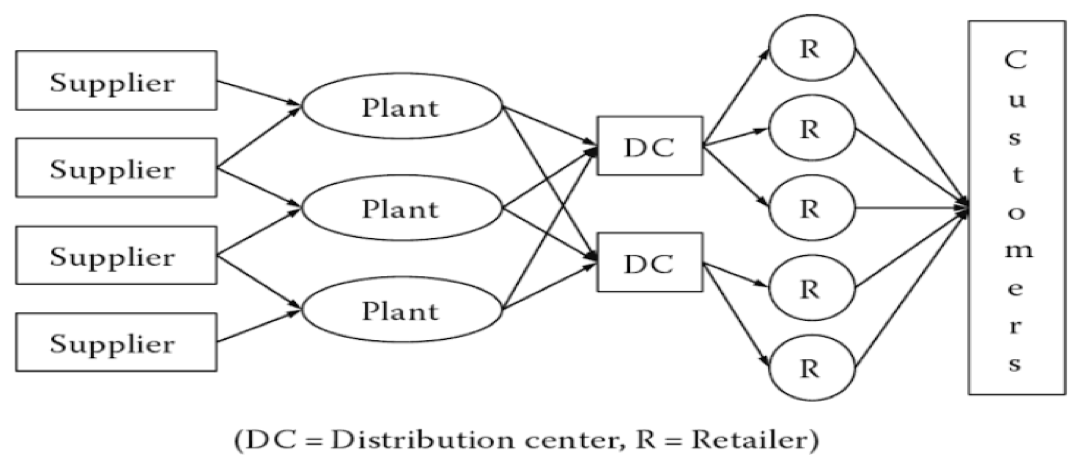
Figure 1 - A typical supply chain (Ravindran & Warsing Jr, 2012).
Several technological tools have made all this information more accurate for applications in the supply chain, some of them includes: bar code, Radio Frequency Identification (RFID), Global Positioning System (GPS). These systems enhance the quality and speed of information, and reduce supply chain risks (Klein et al., 2014).
RFID has gained recognition in Logistics and Manufacturing as an interorganizational system for potentially simplifying processes, and improving supply chain efficiency by providing precise products’ real time information (Zhu et al., 2012; Haddad et al., 2016; Azambuja et al., 2010).
This technology is promising for the supply chain processes optimization, from demand forecasting to planning, managing inventory, and distribution (Ustundag & Tanyas, 2009). RFID is widely used in supply chain management to track goods’ movements throughout the chain, as well as perform inventory control (Ribeiro et al., 2010b).
RFID is not a recent technology; it has been around since World War II. Currently, it has been used to control, ensure and monitor information along the supply chain (Ustundag & Tanyas, 2009). For example, it has been used to track unit load, identify boxes, and to ensure transported items (Asadi, 2011). A brief RFID history is shown in Figure 2.
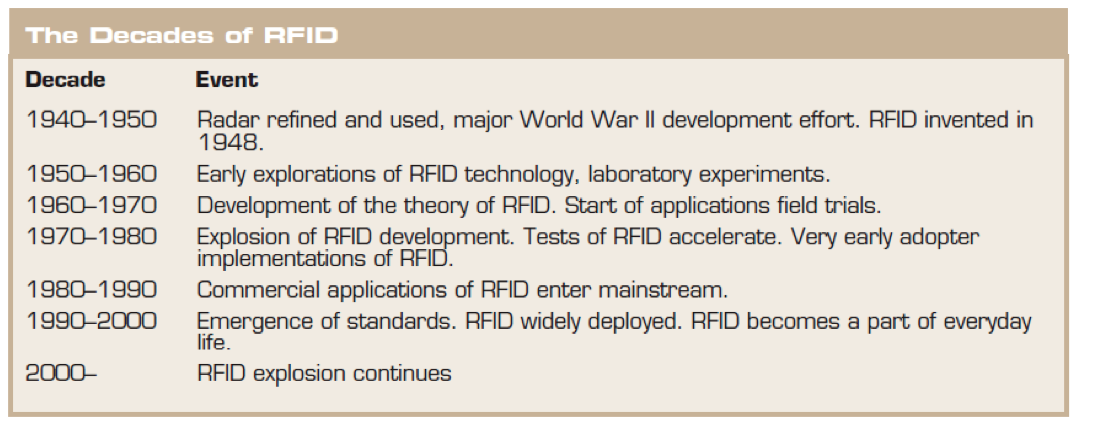
Figure 2 - A brief RFID history (Landt, 2005).
RFID is an automatic identification and data capture technology that is composed of a transponder (or tag), a transceiver (or reader), and a middleware system (Musa & Dabo, 2016). It is based upon utilization of electronic waves as a way to communicate identification data of some elements, such as assets, people and service. Figure 3 shows a brief explanation about the functioning of RFID systems. According to Figure 3, information on the identification of an object (including other possible information that can be monitored by sensors, such as temperature, pressure, etc.) are registered on RFID tags (1), which are attached to items that move or are positioned along the supply chain. Information on the tags is read by a set of sensors (antennas (2), and interrogators (3)) by means of radio frequency. Sensors are customarily distributed at different stages and various positions in the supply chain (control points in distribution centers and warehouses, control points in manufacturing processes and assembly lines, etc.) (Pedroso et al., 2009).
The middleware preprocesses RFID data read by the transceiver to remove incomplete reads and multiple reads to the same transponder. Hence, the middleware bridges RFID hardware and enterprise applications (Musa & Dabo, 2016).
However, in Brazil, RFID has still been little explored by institutions, and studies on this technology are still scarce, both in the academic and practical contexts. Haddad et al. (2016) conducted a structured bibliographic review (using bibliometric techniques). Their research was based on 31 papers from relevant worldwide journals - with publications on the use of RFID in supply chain, especially in retailing - between 2003 and 2014. Among their main conclusions, it was noticed that developed countries (mainly the U.S. and other European countries) have shown a growing interest in RFID applications, which highlights that there is a need for an in-depth investigation on RFID in the industries of developing countries, like Brazil, and thus opens up an opportunity for future studies. (HADDAD et al., 2016).
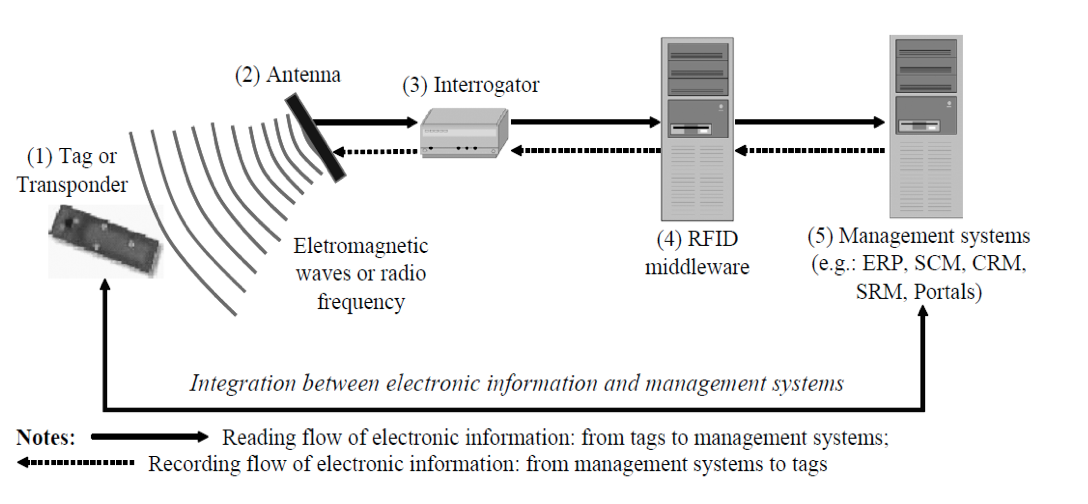
Figure 3 - RFID system function (Pedroso et al., 2009).
This paper aims to analyze the state of art on the use of RFID on supply chain, in Brazil, based on the adopted procedure by Haddad et al. (2016) and Vaz et al. (2015).
This paper’s methodology was a structured literature review, which allowed identifying the most relevant authors, Brazilian states, journals and papers (Section 2), following its main results (Section 3) and finally its conclusions.
In order to develop this paper, it was used the same methods adopted by Haddad et al. (2016) and Vaz et al. (2015). Likewise, the same database, Scopus and Web of Science (WoS) were adopted, with the following keywords: “RFID and Supply chain” which could be displayed on the title, abstract or keywords. The research was conducted in January 2017, involving papers in Portuguese and English, in the Brazilian territory, taking into consideration the entire time period of the bases.
This research turned out 43 papers (35 from Scopus and 8 from Web of Science), which were exported to the paper management software Zotero, where they went through a filtering process. The stages of this process are shown in Table 1.
As the main results from this research, a summary of its quantitative data was obtained. With that, it was first analyzed the chronological paper distribution and then other relevant pieces of information for this research were raised, such as: authors, papers, journals, Brazilian states, main words, as well as institutions and collaboration between countries.
Table 1 - Stages that comprise the paper selection process (Adapted from Haddad et al., (2016))
Stages |
Filters |
Results |
1 - Keywords selection |
“RFID” and “SupplyChain” in the Brazilian territory |
- |
2 - Database selection |
Scopus and Web Of Science |
- |
3 – Searching for papers in databases keywords |
Scopus Web Of Science |
35 8 |
4 – Excluding Repeated papers |
Scopus Web Of Science |
34 2 |
7 – Selection of papers for a full reading. |
- |
36 |
From the 43 papers initially found, only 36 were selected (once 6 of them were in both databases, and 1 was a book chapter), resulting in 96 citations. Most of the papers were written by more than one author, including foreigners. These authors were affiliated to 62 Brazilian and/or International Institutions, divided into two groups: Universities and Companies. Those are distributed across 9 Brazilian states and 5 countries. Table 2 shows a general summary with these data.
Table 2 - Global Data. (Adapted from (Haddad et al., 2016)
Criteria |
Number of |
Papers |
36 |
Authors |
118 |
Journals |
20 |
Brazilians States |
9 |
Institutions |
62 |
Citations |
96 |
Countries |
5 |
Figure 4 shows the chronological distribution of papers per year.
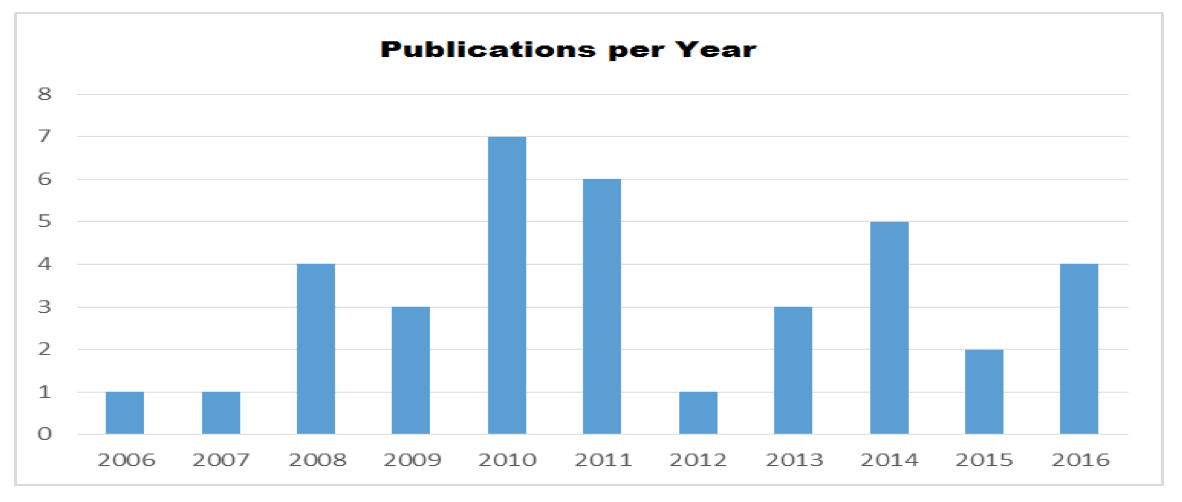
Figure 4 - Chronological distribution (Adapted from Rizzoto et al. (2015))
As shown in Figure 4, publications on RFID started in 2006. The pioneer author on this subject was (Nunes et al., 2006). After that, it is possible to identify an increase of researches on this subject, reaching out its peak in the year 2010. One of the reasons for that may be explained by the tags’ price reduction and their easy access. Besides that, Brazilian currency (Real (BRL)) exchange rate against the US Dollar (USD) at that time may have interfered into this result as well (Figure 5):
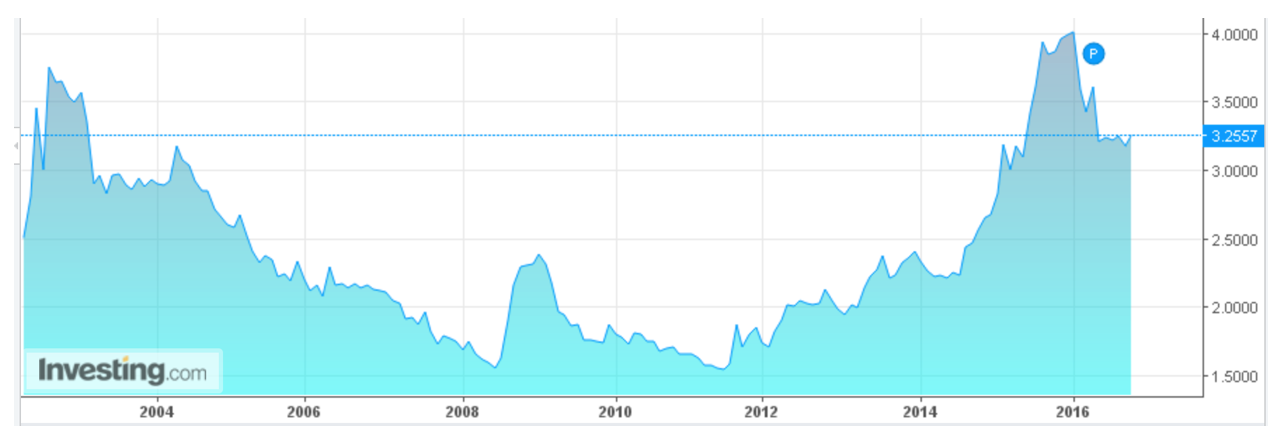
Figure 5 - US Dollar (USD) exchange rate to Brazil Real (BRL) (INVESTING, 2016)).
Through Figure 4, it is also noticed that from 2013 on, two or more papers were published on the topic here proposed, which shows a growing interest in that by authors.
Table 3 shows that out of the found 118 authors, 95 of them have published only one paper. Among the others, although they have published more than one paper, those have not been significant for this paper. However, only one author has authored more than 3 publications: (Ribeiro et al., 2011), (Ribeiro et al., 2010a), (Ribeiro et al., 2010b), and (Scavarda et al., 2009).
Table 3 - Number of papers per authors (Adapted from Haddad et al. (2016).
Number of authors |
Number of papers |
95 |
1 |
12 |
2 |
10 |
3 |
1 |
4 |
In terms of papers’ relevance, Table 4 shows the ten most cited ones – through Google Scholar.
Table 4 - The most cited papers (Adapted from (Haddad et al., 2016)).
Ranking |
Authors |
Title |
Year |
Citation Count |
1 |
Pedroso M.C., Zwicker R., Alexandre De Souza C. |
RFID adoption: Framework and survey in large Brazilian companies |
2009 |
28 |
2 |
Le T.D., Kim S.H., Nguyen M.H., Kim D., Shin S.Y., Lee K.E., Da Rosa Righi R. |
EPC information services with No-SQL datastore for the Internet of Things |
2014 |
10 |
3 |
de Azambuja M.C., Jung C.F., ten Caten C.S., Hessel F.P. |
RFID-Env: Methods and software simulation for RFID environments |
2010 |
9 |
4 |
Ribeiro P.C.C., Scavarda A.J., Batalha M.O. |
RFID in the international cattle supply chain: Context, consumer privacy and legislation |
2010 |
7 |
5 |
Nemoto M.C.M.O., de Vasconcellos E.P.G., Nelson R. |
The adoption of new technology: Conceptual model and application |
2010 |
7 |
6 |
Tavares J.J.-P.Z., Saraiva T.A. |
Elementary Petri net inside RFID distributed database (PNRD) |
2010 |
5 |
7 |
Azambuja M., Marcon C., Hessel F. |
A communication protocol and physical characteristics simulator for an RFID sensor environment |
2008 |
5 |
8 |
Campos L.B., Zorzo S.D. |
A domain analysis approach for engineering RFID systems in supply chain management |
2007 |
4 |
9 |
Gogliano O., Eduardo Cugnasca C. |
An overview of the EPCglobal® network |
2013 |
4 |
10 |
Jaggi A.S., Sawhney R.S., Balestrassi P.P., Simonton J., Upreti G. |
An experimental approach for developing radio frequency identification (RFID) ready packaging |
2014 |
4 |
According to Table 4, the paper with most citations (28) was “RFID adoption: Framework and survey in large Brazilian companies” (Pedroso et al., 2009). Its purpose is to provide a framework for RFID technology adoption considering its applications, expected benefits, motivators, inhibitors, and organizational factors. Other papers among the most cited are (Le et al., 2014); (Azambuja et al., 2010); (Ribeiro et al., 2010b) with 10, 9 e 7 citations, respectively.
It is important to point out that the author Scavarda besides having the largest number of published papers (Table 3), also has one of his paper included in the list of the most cited ones: “RFID in the international cattle supply chain: Context, consumer privacy and legislation” (Ribeiro et al., 2010b).
Regarding the journals, 14 were identified in this portfolio. They were distributed into distinct journals, which show that there is no concentration on the subject proposed in this research in specific journals.
Among those 14, 7% are classified as A (the most relevant), 50% B, 7% C, and 36% are not classified into Qualis Capes database 2015 as “Engenharia III” (Engineering III) – category for publications in Production Engineering, which is the focus of this study.
In addition to that, it was analyzed both the Impact Factor and the CiteScore index, once this paper used two different databases. Those indexes are related to Web of Science and Scopus respectively. Table 5 presents the most relevant journals and their indexes.
Table 5 – The most relevant journals (Adapted from (Haddad et al., 2016)).
Journal |
Publications |
Qualis Capes (ENG. III) |
Impact Factor |
CiteScore |
Journal of cleaner production |
1 |
A1 |
4.959 |
5.57 |
International journal of production research |
1 |
B1 |
1.693 |
2.29 |
Industrial management and data systems |
1 |
B1 |
1.278 |
2.06 |
IEEE Latin America Transactions |
1 |
B2 |
0.436 |
0.63 |
Business process management journal |
1 |
B3 |
- |
2.55 |
International journal of services and operations management |
1 |
B3 |
- |
1.28 |
International journal of business excellence |
1 |
B3 |
- |
0.94 |
Journal of Technology Management and Innovation |
1 |
B3 |
- |
0.62 |
Espacios |
1 |
C |
- |
0.06 |
Journal of global information management |
1 |
- |
0.303 |
- |
International sugar journal |
1 |
- |
0.181 |
0.16 |
International journal of engineering business management |
1 |
- |
- |
0.86 |
Procedia Computer Science |
1 |
- |
- |
0.85 |
Stahl und Eisen |
1 |
- |
- |
0.08 |
Regarding to the Brazilian states and international countries, where the relevant universities are located in, Figure 6 shows that there are 9 Brazilian states into this research. São Paulo (SP), Rio Grande do Sul (RS) and Rio de Janeiro (RJ) were the states with the most publications. For a thorough analysis, it will be demonstrated correlation networks between the Brazilian states (with their respective universities) and countries, since several works were developed by universities located in several Brazilian states besides other countries.
It is important to highlight that in this analysis it was considered only the number of authors; not the papers, since several works were developed by a sets of authors affiliated to a variety of national universities. For example, the paper RFID in the international cattle supply chain: Context, consumer privacy and legislation policies (Ribeiro et al., 2010b) was developed by the University of Sao Carlos (SP) in collaboration to authors affiliated to American and Arabian Institutions.
Figure 6 shows that the universities in the state of São Paulo has led the list of the universities with the largest number of publications (27 published papers), which represents three times more than Rio Grande do Sul’s – second on this ranking.
Figure 6 - Publications per Brazilian state (Adapted from (Haddad et al., 2016)).
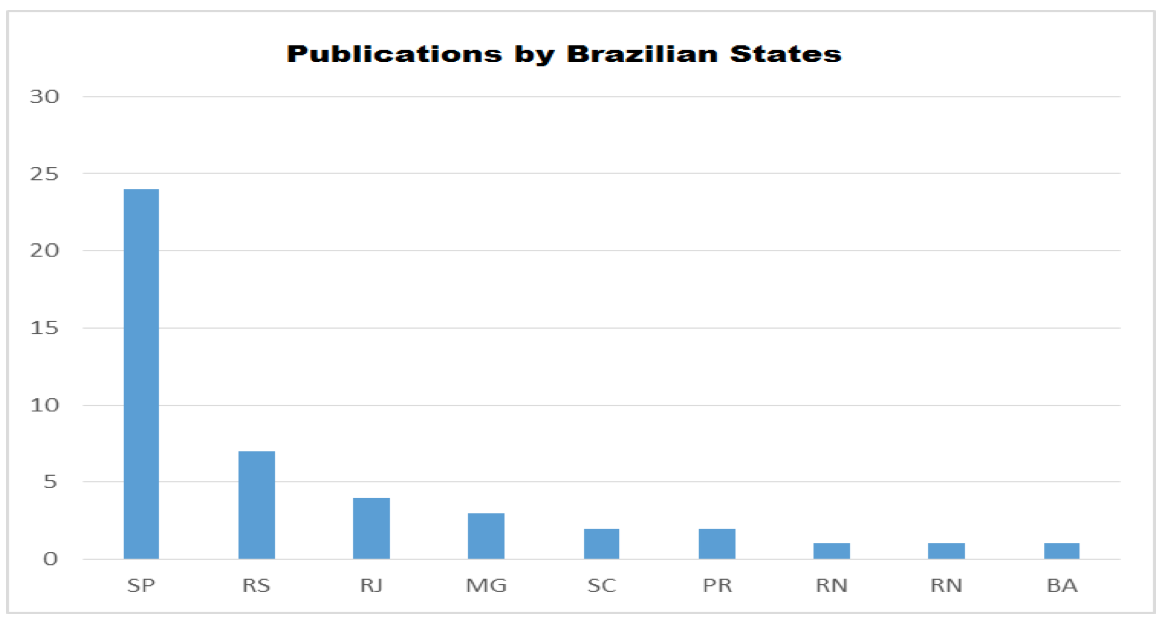
Figure 7 presents the ranking of the ten Brazilian universities with the largest number of publications. Among them, the University of Sao Paulo (USP) shows 7 publications, which 3 of them were developed with other collaboration from other universities: Cost assessment and benefits of using RFID in reverse logistics of waste electrical & Electronic equipment (WEEE). (Araujo et al., 2015); An overview of the EPCglobal® network (Gogliano & Cugnasca, 2013) ; Hunter - Hybrid unified tracking environment - Real-time identification and tracking system using RFID technology. (Foina & Fernandez, 2008). Once more, it proves the relevance of the state of São Paulo on this subject, once the third first places on this ranking is taken by universities from Sao Paulo: USP, UFSCar e UNIFEI, respectively.
Figure 7 - Institutions to which authors are affiliated.
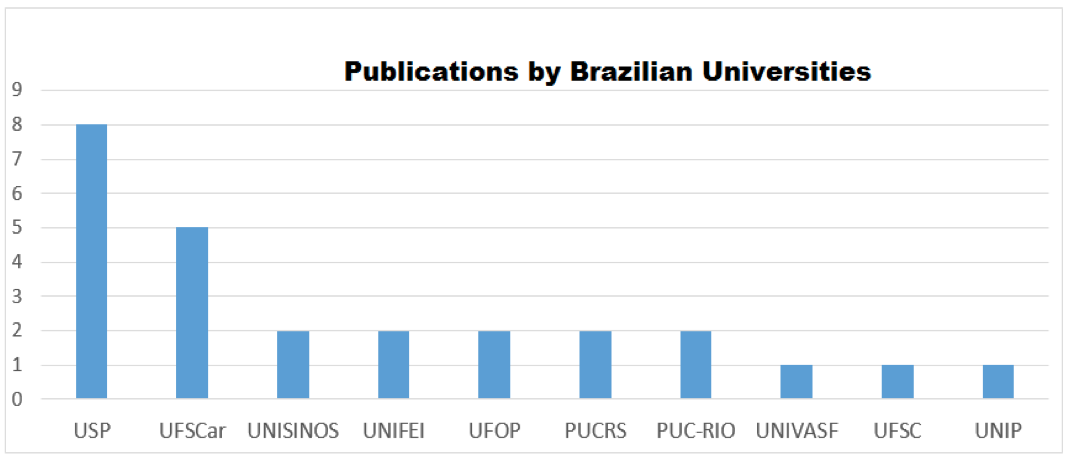
On the other hand, Figure 8 shows the existence of collaboration networks between Brazilian Institutions; they surpass State boundaries. Through the analyzed data, it was found 3 occurrences between SP and Minas Gerais (MG); and only 1 between Rio Grande do Sul (RS) and SP; and Bahia (BA) and SP.
Also in Figure 8, it is noted that the connection between UFOP and UFSCar is larger than the others – its arrow is thicker. Once again, the state of São Paulo is highlighted on this research.
Figure 8 - Collaboration network between Brazilian universities (Developed by the authors (2017)).
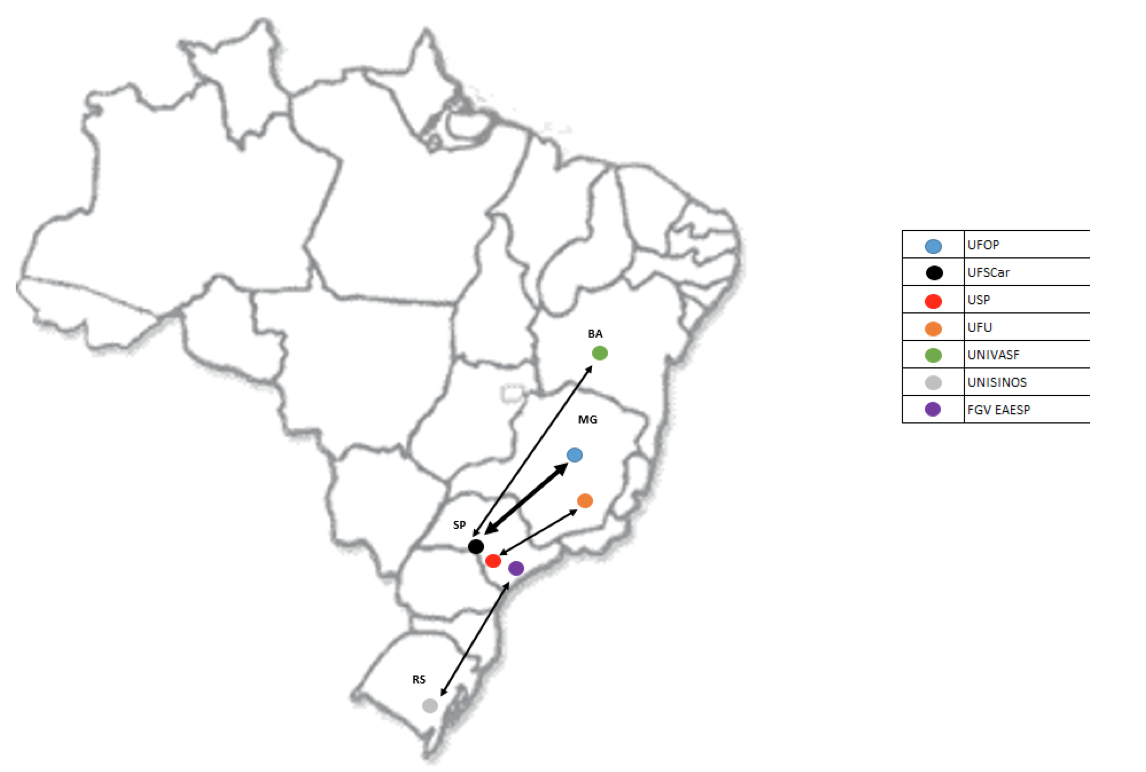
Moreover, Figure 9 shows a collaboration network between Brazil and other countries. The respective number of collaboration is: USA (6 occurrences), United Arab Emirates (3), and 1 for Germany, South Korea, and Australia.
Figure 9 - Collaboration network between Brazil and other countries (Developed by the authors (2017)).
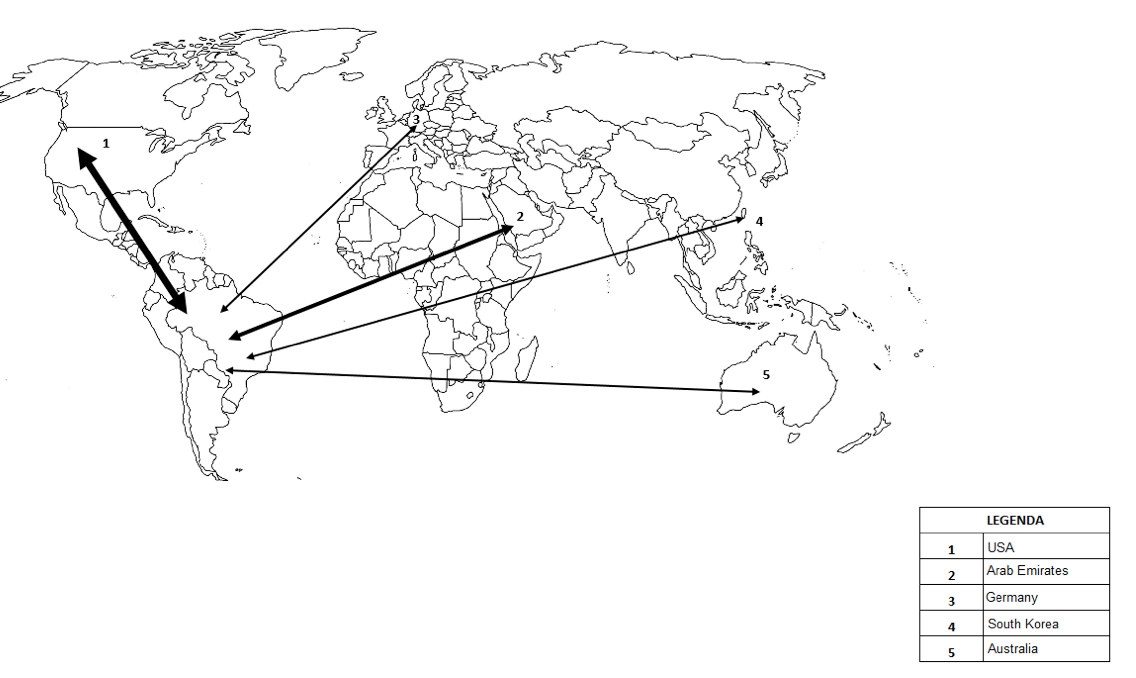
For a better data representation, a word cloud is shown in Figure 10, which displays the words that appear more frequently in the titles of the papers collected. The larger the words, the more frequent they were in the paper portfolio. This word cloud was built using R (R Core Team, 2015) and its package wordcloud.
In order to obtain a clearer visualization, the words considered as irrelevant for this analysis were taken out. Such words include prepositions, definite/indefinite articles, and symbols. For example, it was disregarded the following words: and, in, of, the, for, an, a, -, &, 5, that, with,:, (, ).
On the other hand, Table 6 lists the ten most frequent keywords used.
Figure 10 - Theme-paper representativeness.
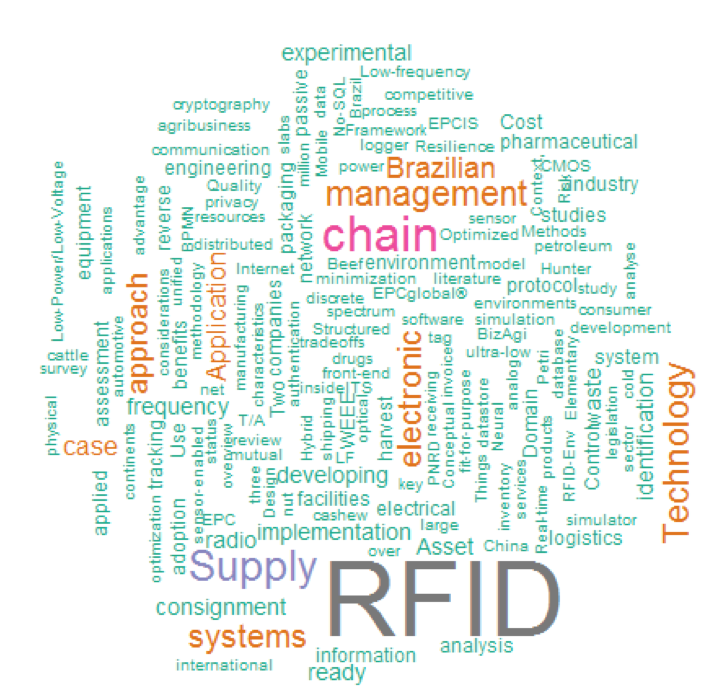
Table 6 - Most frequent keywords
Words |
Frequency |
RFID |
20 |
Supply chain management |
4 |
GIS |
3 |
GPS |
3 |
Harvesting |
3 |
Innovation |
3 |
radio frequency identification |
3 |
Rfid tags |
3 |
Sugarcane |
3 |
Supply chain |
3 |
Table 7 lists RFID applications in different supply chains with their respective references.
Table 7 – RFID applications in supply chain
RFID Applications |
Supply Chain Management |
Retail Chain Management |
Logistics and Transportation |
Manufacturing |
Construction |
Agricultural and Food |
Pharmaceutical |
Automobile |
Technology |
Petroleum |
Others |
Pedroso et al. (2009) |
X |
X |
X |
|
|
|
|
|
|
|
|
Azambuja et al. (2010) |
X |
|
X |
|
|
|
|
|
|
|
|
Le et al. (2014) |
|
|
|
|
|
|
|
|
|
|
X |
Ribeiro et al. (2010)a |
|
|
|
|
|
X |
|
|
|
|
|
Nemoto et al. (2010) |
|
|
|
|
|
|
|
|
|
|
X |
Tavares & Saraiva (2010) |
|
|
|
|
|
|
|
|
|
|
X |
Azambuja et al. (2008) |
|
|
|
|
|
|
|
|
|
|
X |
Campos & Zorzo (2007) |
X |
|
|
|
|
|
|
|
|
|
|
Gogliano & Cugnasca (2013) |
X |
|
|
|
|
|
|
|
|
|
|
Cortes et al. (2013) |
|
|
|
|
|
|
|
|
|
|
X |
Cortes et al. (2011) |
|
|
|
X |
|
|
|
|
|
|
|
Jaggi et al (2014) |
|
|
X |
|
|
|
|
|
|
|
|
Ribeiro et al. (2011) |
|
|
|
|
|
X |
|
|
|
|
|
Ribeiro et al. (2010)b |
|
|
|
|
|
X |
|
|
|
|
|
Leme et al. (2008) |
|
|
|
|
|
|
|
|
X |
|
|
Jaggi et al. (2011) |
X |
|
|
X |
X |
|
|
|
|
|
|
Araujo et al. (2015) |
|
|
|
|
|
|
|
|
X |
|
|
Moreira et al., (2014) |
|
|
|
|
|
X |
|
|
|
|
|
Da Costa & de Oliveira (2013) |
|
|
|
X |
|
|
|
|
|
|
|
Borin et al. (2012) |
|
|
|
|
|
|
|
|
|
|
X |
Rasim et al. (2011) |
|
|
|
X |
|
|
|
|
|
|
|
Marrero et al. (2011) |
|
|
|
|
|
X |
|
|
|
|
|
Jaggi et al. (2011) |
|
|
X |
|
|
|
|
|
|
|
|
Kotsuka et al. (2010) |
|
|
|
|
|
|
|
|
|
|
X |
Marrero et al. (2010) |
|
|
|
|
|
X |
|
|
|
|
|
Firmino et al. (2009) |
|
|
|
|
|
|
|
|
|
|
X |
Scavarda et al., (2009) |
X |
|
|
X |
|
|
|
|
|
|
|
Campos & Zorzo (2008) |
|
X |
|
|
|
|
|
|
|
|
|
Foina & Fernandez (2008) |
|
|
|
|
X |
|
|
|
|
|
|
Nunes et al. (2006) |
|
|
|
|
|
|
|
X |
|
|
|
Klein et al. (2014) |
|
|
|
|
|
X |
|
|
|
|
|
Candido et al. (2015) |
|
|
|
|
|
X |
|
|
|
|
|
Dos Santos et al. (2015) |
|
|
|
|
|
|
X |
|
|
|
|
(Amaral et al. (2015) |
|
|
|
|
|
|
X |
|
|
|
|
HADDAD et al. (2016) |
|
X |
|
|
|
|
|
|
|
|
|
Hoeflich et al. (2014) |
|
|
|
|
|
|
|
|
|
X |
|
TOTAL |
6 |
3 |
4 |
5 |
2 |
8 |
2 |
1 |
2 |
1 |
8 |
By analyzing Table 7, it can be observed that RFID has been used in a variety of applications. Especially, the most predominant areas are: Supply Chain Management, Manufacturing, Agriculture and Food, Technology, among others.
The authors unanimously agree that RFID brings numerous benefits to the Supply Chain Management for improving its items traceability. Specifically on Logistics, they state that RFID applications are related to internal processes between industries such as delivery, transportation, and items receiving.
In Brazil, it has been noticed an increase of its use in Agriculture and Livestock. From the works collected, they highlight the use of RFID in the beef supply chain, especially during the identification and animal tracking processes. Besides that, it has recently been developed works in the Pharmaceutical Industry.
Furthermore, it is worth mentioning that some papers were classified as “others”, once they approached the topics here proposed in a technical view.
This paper aimed to analyze the state of art on RFID and its application on Supply Chain in Brazil. RFID has been a promising technology that is in steady growth abroad for bringing several benefits for the supply chain.
From the structured literature review, it was possible to identify that the number of publication on the proposed subject here increased during 2010 and 2011, which may be explained by the U.S. Dollar (USD) currency exchange rate to Brazil Real (BRL). After these years, the publications declined, which shows a demotivation from Brazilians on this topic. Thus, it is recommended for future works to monitor RFID in Brazil not only on supply chain but in any other area.
In terms of the Brazilian states, the predominance of the state of Sao Paulo is evident, considering the number of citations, collaborations and publications in relevant journals for Production Engineering. Besides that, three universities from Sao Paulo ranked the third first places on collaboration between universities. Another analyzed factor was the evident predominance of the U.S. on this topic, once it has the largest number of collaboration with Brazil.
It is worth highlighting that journals publish mostly papers in the English language, which makes it difficult to disseminate studies from countries where the mother tongue is not English. Indeed, among all the selected papers, only 1 was in written Portuguese and 1 in Spanish, which emphasizes the relevance of papers published in English for RFID literature.
Also, it was possible to notice during this paper’s development a partnership between universities and companies (Brazilians and Internationals) in the publications. But this paper focused on analyzing only universities; not companies. However, it is possible to obtain this data by simply following this paper’s methodology. So, it is suggested to study thoroughly on the RFID adoption and development in Brazilian companies.
Regarding RFID applications, it is pointed out some improvements provided to some areas such as Supply chain Management, Manufacturing, agricultural and food, technological, among others. In Brazilian Agriculture, it was noticed a growth for the adoption of RFID on tracking, and animal identification. Besides that, this technology has recently been used in the Pharmaceutical Industry. Thus, it opens up opportunities for future researches on these areas.
AMARAL, Patricia, dos S.; DOS SANTOS, Marcus, V.; & Costa, L. (2015). Porposal for EPCIS system implementation to control drugs in pharmaceutical sector in Brazil. RFID, 2015 IEEE Brasil, 48–51.
ARAUJO, Marcus, V. F. de, OLIVEIRA, Uanderson, R. de; MARINS, Fernando, A. S.; MUNIZ Jr., Jorge (2015). Cost Assessment and Benefits of Using RFID in Reverse Logistics of Waste Electrical & Electronic Equipment (WEEE). Procedia Computer Science, 55, 688–697.
ASADI, Shokoofeh (2011). Logistics system: Information and communication technology. Logistics Operations and Management: Concepts and Models, 221–245.
AZAMBUJA, Marcelo, C. de; JUNG, Carlos, F; SCHWENGBER TEN CATEN, Carla; HESSEL, Fabiano, P. (2010). RFID-Env: methods and software simulation for RFID environments. Business Process Management Journal, 16(6), 1014–1038.
AZAMBUJA, Marcelo, C. de; MARCON, C.; HESSEL, F. (2008). A Communication Protocol and Physical Characteristics Simulator for an RFID Sensor Environment. In 2008 International Wireless Communications and Mobile Computing Conference (p. 1093–1098). IEEE.
BORIN, Rogério; BOSCHI, Alexandre A.; BATOCCHIO, Antonio; COSTA, Ivanir; RAYMUNDO, Júlio C. (2012). The Competitive Advantage for the Companies that Use Electronic Invoice and RFID–An Analyse Using BizAgi BPMN. In IE Conference & Expo. Orlando, USA.
CAMPOS, Leonardo B.; ZORZO, Sérgio D. (2007). A Domain Analysis Approach for Engineering RFID Systems in Supply Chain Management. In 2007 IEEE International Conference on System of Systems Engineering (p. 1–6). IEEE.
CAMPOS, Leonardo B.; ZORZO, Sérgio D. (2008). Domain analysis: A case study of engineering RFID systems in supply chain. In Proceedings of the 2008 International Conference on Software Engineering Research and Practice (p. 24–31), SERP 2008, Las Vegas, NV; United States.
CANDIDO, Roberto; MARTINEZ, Javier; SILVA, José R. (2015). Using RFID technology to enhance quality information to products in agribusiness supply chain. In RFID, 2015 IEEE Brasil (p. 43–47). São Paulo; Brazil: IEEE.
CORTES, Fernando P.; FREITAS, Guilherme; PIMENTEL, Henrique L. A.; BRITO, Juan P. M.; CHAVEZ, Fernando (2013). Low-power/low-voltage analog front-end for LF passive RFID tag systems. In Integrated Circuits and Systems Design (SBCCI), 2013 26th Symposium on (p. 1–6). IEEE.
CORTES, Fernando P.; SCHMIDT, Rafael; COURCELLE, Laurent; PESSATTI, Murilo (2011). Low-frequency passive RFID systems implementation in CMOS technology: design considerations and tradeoffs. In Proceedings of the 24th symposium on Integrated circuits and systems design (p. 1–4). ACM.
DA COSTA, Cesar; DE OLIVEIRA, Lais R. (2013). RFID applications to the optimization of discrete manufacturing process. In IEEE International Conference on Signal Processing, Computing and Control, ISPCC 2013, Shimla, HP; India.
DOS SANTOS, J. C. S.; GOMES, F. O. O.; DOS SANTOS, M. A.; GRANDO, N.; TRAVESSINI, R.; WEIRICH, R. S.; DE CASTRO, M. C. F. (2015). Optimized ultra-low power sensor-enabled RFID data logger for pharmaceutical cold chain. In RFID, 2015 IEEE Brasil (p. 18–22). São Paulo; Brazil: IEEE.
FIRMINO, Macêdo; BRANDÃO, Gláucio B.; GUERREIRO, Ana M.; VALENTIM, Ricardo A. de M. (2009). Neural cryptography applied to key management protocol with mutual authentication in RFID systems. In Internet Technology and Secured Transactions, 2009. ICITST 2009. International Conference for (p. 1–6). IEEE.
FOINA, Aislan G.; FERNANDEZ, Francisco J. R. (2008). HUNTER HYBRID UNIFIED TRACKING ENVIRONMENT.
GOGLIANO, Osvaldo; CUGNASCA, Carlos E. (2013). An Overview Of The EPCglobal Network. IEEE Latin America Transactions, 11(4), 1053–1059.
HADDAD, Carolina R.; RIZZOTTO, Fernando H.; MALDONADO, Mauricio U. (2016). Structured review of the literature on RFID and its application in supply chain. Espacios, 37, 19.
HOEFLICH, S. L.; BLOS, M. F.; DIAS, E. M. (2014). Resilience methodology for the petroleum supply chain - An approach using the radio frequency (RFID) technology. In 6th CCPS Latin American Conference on Process Safety 2014, LACPS 2014, 2, p. 831–837, Buenos Aires; Argentina.
JAGGI, Amoldeep S.; SAWHNEY, Rapinder S.; BALESTRASSI, Pedro P. (2011). An Experimental Approach for Developing RFID Ready Receiving and Shipping. In 61st Annual IIE Conference and Expo Proceedings, Reno, NV; United States.
JAGGI, Amoldeep S.; SAWHNEY, Rapinder S.; BALESTRASSI, Pedro P.; SIMONTON, James; UPRETI, Girish (2014). An experimental approach for developing radio frequency identification (RFID) ready packaging. Journal of Cleaner Production, 85, 371–381.
KOTSUKA, Alberto T.; CARVALHO, Andre de S.; PACÍFICO, Wagner S. (2010). Supply chain system through ITS technology. In 7th World Congress on Intelligent Transport Systems, Busan; South Korea.
KLEIN, Amarolinda Z.; DA COSTA, Eliane G.; VIEIRA, Luciana M.; Teixeira, Rafael (2014). The Use of Mobile Technology in Management and Risk Control in the Supply Chain: The Case of a Brazilian Beef Chain. Journal of Global Information Management (JGIM), 22(1), 14–33.
LANDT, Jeremy (2005). The history of RFID. IEEE potentials, 24(4), 8–11.
LE, Tuan D.; KIM, Seong H.; NGUYEN, Minh H.; KIM, Daeyoung; SHIN, Seung Y.; LEE, Kyung E.; DA ROSA , Rodrigo R. (2014). EPC information services with No-SQL datastore for the Internet of Things. In 2014 IEEE International Conference on RFID (IEEE RFID), p. 47–54. IEEE.
LEME, Claudia B.; MOSSO, Marbey M.; PODCAMENI, Abelardo (2008). Rfid applied to optical spectrum for network resources inventory management. In Mobile Ubiquitous Computing, Systems, Services and Technologies, 2008. UBICOMM’08. The Second International Conference, p. 1–6. IEEE.
MARRERO, S.; PONCE, E.; GUERRERO, A.; SEFTON, M.; CAMACHO, A.; DI BELLA, L. P.; DE LAI, R.; GIRGENTI, A. (2010). Asset management and electronic consignment. In 32nd Annual Conference of the Australian Society of Sugar Cane Technologists 2010, Bundaberg; Australia.
MARRERO, S.; PONCE, E.; GUERRERO, A.; SEFTON, M.; CAMACHO, A.; DI BELLA, L. P.; DE LAI, R.; GIRGENTI, A. (2011). Asset management and electronic consignment. International Sugar Journal, 113, 301–304.
MOREIRA, Edmilson C.; FREITAS, Romeu; MORAIS, Alexei; SOMBRA, Antonio S. B. (2014). RFID in cashew nut industry. In Brasil RFID, 2014 IEEE (p. 31–34). IEEE.
MUSA, Ahmed; DABO, Al-Amin A. (2016). A Review of RFID in Supply Chain Management: 2000–2015. Global Journal of Flexible Systems Management, 1–40.
NEMOTO, Miriam C. M. O.; VASCONCELLOS, Eduardo P. G. de; NELSON, Reed (2010). The adoption of new technology: conceptual model and application. Journal of technology management & innovation, 5(4), 95–107.
NUNES, Kátia R.; SCHNATMEYER, Martin; THOBEN, Klaus-Dieter; VALLE, Rogério A. (2006). Using RFID for waste minimization in the automotive industry. In IFAC Proceedings Volumes, 39(3), 221–226.
PEDROSO, Marcelo C.; ZWICKER, Ronaldo; DE SOUZA, Cesar A. (2009). RFID adoption: framework and survey in large Brazilian companies. Industrial Management & Data Systems, 109(7), 877–897.
R Core Team (2015). R: A language and environment for statistical computing. R Foundation for Statistical Computing, Vienna, Austria. Retrieved from https://www.R-project.org/
RASIM, Wolfgang.; ZENTARA, Norbert; ANDRZEJEWSKI, Peter; SCHUERINGS, Joachim; JUENGST, Andre; DECKER, Burkhard; LANGENFURTH, Dirk; EBENSPERGER, Andreas; BOSSELMANN, Carsten; CARVALHAL, Luiz. (2011). A fit-for-purpose supply chain for 5 million t/a of slabs over three continents. Stahl und Eisen: Zeitschrift fuer die Herstellung und Verarbeitung von Eisen und Stahl, (11), 45–60.
RAVINDRAN, Ravi; WARSING, Donald P. (2012). Supply chain engineering: Models and applications. CRC Press.
RIBEIRO, Priscila C. C.; BATALHA, Mário O.; SCAVARDA, Annibal J. (2010a). Application of RFID in Brazilian harvest facilities: Two case studies. In WMSCI 2010 - The 14th World Multi-Conference on Systemics, Cybernetics and Informatics, Proceedings, 1, p. 199–203, Orlando, FL; United States.
RIBEIRO, Priscila C. C.; SCAVARDA, Annibal J.; Batalha, Mário O. (2010b). RFID in the international cattle supply chain: context, consumer privacy and legislation. International Journal of Services and Operations Management, 6(2), 149–164.
RIBEIRO, Priscila C. C.; SCAVARDA, Annibal J.; BATALHA, Mário O. (2011). The Application of RFID in Brazilian Harvest Facilities: Two Case Studies. International Journal of Engineering Business Management, 3(1.), 57–63.
SCAVARDA, Annibal J.; O’NEILL, Peter; SCAVARDA, Luiz F.; WANG, Xiaoyang. (2009). The development and implementation status of RFID in China. International Journal of Business Excellence, 2(3–4), 317–329.
TAVARES, José J.-P. Z. D. S.; SARAIVA, Thiago A. (2010). Elementary Petri net inside RFID distributed database (PNRD). International Journal of Production Research, 48(9), 2563–2582.
USTUNDAG, Alp; TANYAS, Mehmet (2009). The impacts of radio frequency identification (RFID) technology on supply chain costs. Transportation Research Part E: Logistics and Transportation Review, 45(1), 29–38.
VAZ, Caroline R.; INOMATA, Danielly O.; MALDONADO, Maurício U.; SELIG, Paulo M.; VARVAKIS, Gregório (2015). State of The Art on Intellectual Capital Research in Brazil: A Structured Literature Review (2001-2014). Business and Management Review, 4, 463-472
ZHU, Xiaowei; MUKHOPADHYAY, Samar K.; KURATA, Hisashi (2012). A review of RFID technology and its managerial applications in different industries. Journal of Engineering and Technology Management, 29(1), 152–167.
1. UENF– Universidade Estadual do Norte Fluminense – Campos dos Goytacazes/RJ - Brasil - email: cristianomo@pq.uenf.br
2. UENF– Universidade Estadual do Norte Fluminense – Campos dos Goytacazes/RJ - Brasil - email:patricksoares@pq.uenf.br
3. UENF– Universidade Estadual do Norte Fluminense – Campos dos Goytacazes/RJ - Brasil - email:gudelia@uenf.br
4. UENF– Universidade Estadual do Norte Fluminense – Campos dos Goytacazes/RJ - Brasil - email:arica@uenf.br
5. UCAM – Universidade Cândido Mendes – Campos dos Goytacazes/RJ - Brasil - email: italo@ucam-campos.brn